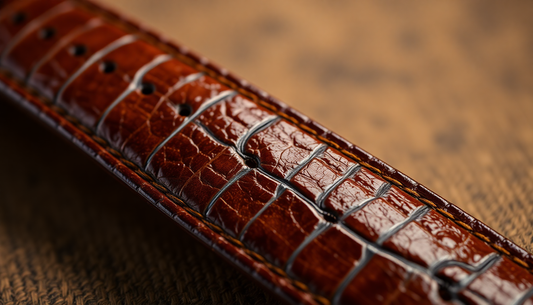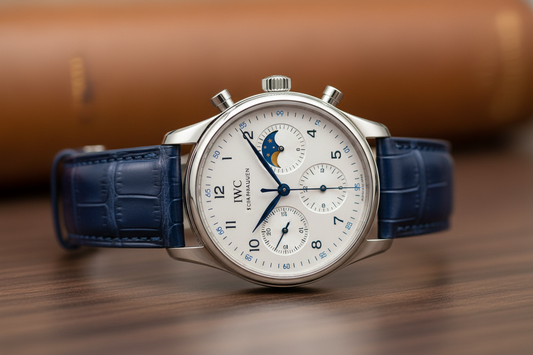Luxury Watches: Alligator Leather Straps Guide
In the realm of luxury watches, alligator leather straps hold a special place. They are known for their durability, unique patterns, and luxurious texture.
This guide aims to educate you about these exquisite straps. From identifying genuine alligator leather to understanding its craftsmanship, we've got you covered.
Whether you're a watch enthusiast or a potential buyer, this guide will help you make an informed choice about alligator leather straps.
The Allure of Alligator Leather
Alligator leather is a symbol of luxury and exclusivity. Its unique patterns and textures make each strap one-of-a-kind.
This leather is renowned for its durability. It can withstand the test of time, making it a popular choice for high-end watch brands.
Moreover, genuine alligator leather straps are often handcrafted. This adds to their charm and makes them a sought-after accessory for luxury watches.
Identifying genuine alligator leather can be a challenge. It's crucial to know the key characteristics to avoid imitations.
Genuine alligator leather has unique patterns. Each scale has its own shape and size, unlike synthetic materials.
Also, look for CITES certification. This ensures the leather is sourced ethically and complies with international wildlife trade regulations.
Crafting an alligator leather strap is an art. It involves careful selection, cutting, and stitching of the leather.
The tanning process is also crucial. It determines the strap's color and durability. A well-crafted strap can last for years with proper care.
Choosing the Right Alligator Strap for Your Watch
Selecting the right alligator strap is a personal choice. It depends on your watch style, wrist size, and personal preference.
The strap should complement your watch and feel comfortable on your wrist. It should also match your style and the occasions you plan to wear it.
Remember, a well-chosen alligator strap can enhance the overall look of your luxury watch.
Strap Size and Fit
The size and fit of the strap are crucial. The strap should fit snugly on your wrist, not too tight or too loose.
The width of the strap should match the lug width of your watch. This ensures a seamless fit and a balanced look.
Color, Texture, and Finish
Alligator leather straps come in various colors, textures, and finishes. The color should match or complement your watch and your wardrobe.
The texture and finish of the strap add to its uniqueness. Matte, shiny, or semi-gloss - choose what suits your style.
Buckles and Closures
The buckle or closure of the strap is also important. It should be sturdy and easy to use.
Some straps come with a deployant clasp for added security. Others have a traditional buckle. Choose what you find most comfortable and practical.
Caring for Your Alligator Leather Strap
Proper care can extend the life of your alligator strap. It can also maintain its luxurious look and feel.
Avoid exposing the strap to water or harsh chemicals. These can damage the leather and fade its color.
Regular cleaning with a soft cloth can keep your strap looking its best.
Maintenance and Longevity
To maintain the strap's longevity, use a leather conditioner. This can prevent the leather from drying out and cracking.
Avoid wearing the same strap every day. Rotating between different straps can prevent excessive wear and tear.
Proper Storage
When not in use, store your strap in a cool, dry place. Avoid direct sunlight and high temperatures, as these can damage the leather.
Ethical Considerations and Sustainability
Alligator leather production is regulated to ensure sustainability. It's important to buy from brands that adhere to these regulations.
Ethical considerations also include the treatment of alligators. Ensure your strap comes from a source that treats animals humanely.
Where to Purchase Alligator Leather Straps
Genuine alligator leather watch strap can be bought from luxury watch retailers. They often offer a range of options, from pre-made to custom designs.
Online platforms also sell these straps. Always check for authenticity before purchasing.








